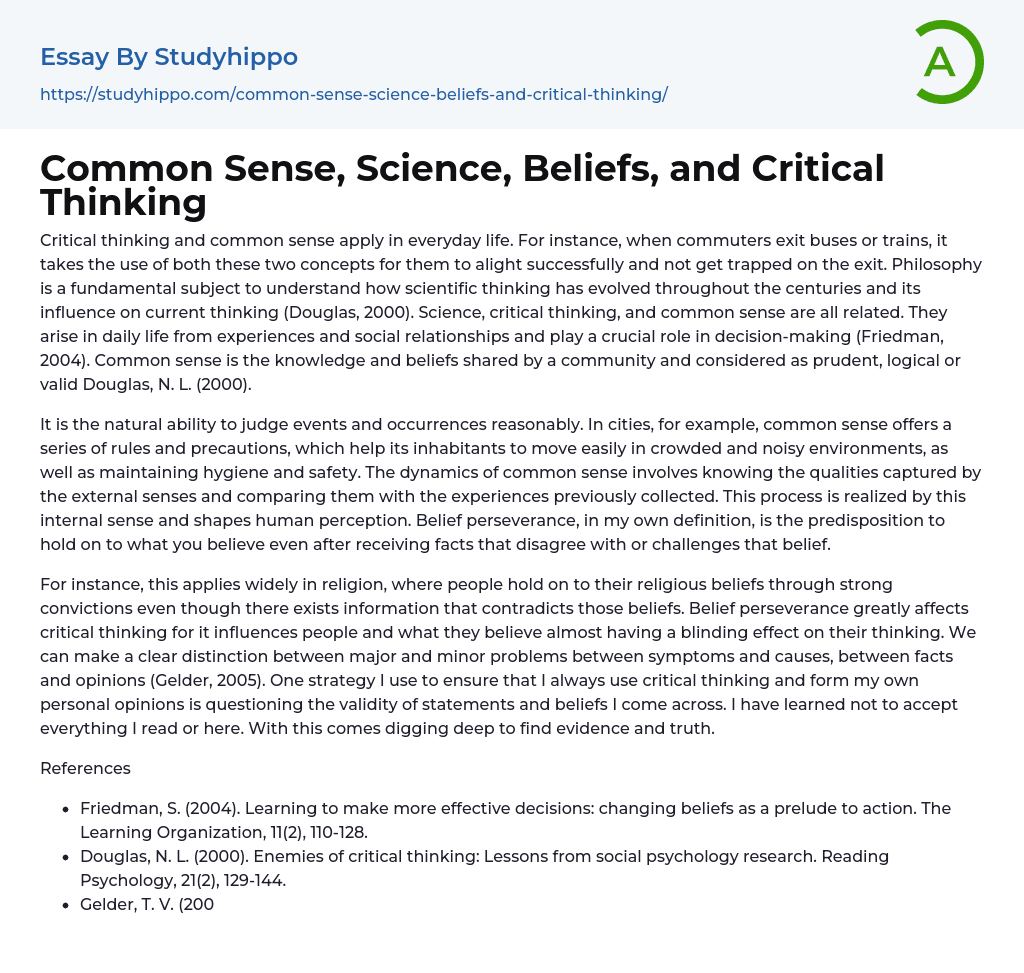

Common Sense, Science, Beliefs, and Critical Thinking Essay Example
Critical thinking and common sense apply in everyday life. For instance, when commuters exit buses or trains, it takes the use of both these two concepts for them to alight successfully and not get trapped on the exit. Philosophy is a fundamental subject to understand how scientific thinking has evolved throughout the centuries and its influence on current thinking (Douglas, 2000). Science, critical thinking, and common sense are all related. They arise in daily life from experiences and social relationships and play a crucial role in decision-making (Friedman, 2004). Common sense is the knowledge and beliefs shared by a community and considered as prudent, logical or valid Douglas, N. L. (2000).
It is the natural ability to judge events and occurrences reasonably. In cities, for example, common sense offers a series of rules and precautions, which help its inhabitants to move easily in
...crowded and noisy environments, as well as maintaining hygiene and safety. The dynamics of common sense involves knowing the qualities captured by the external senses and comparing them with the experiences previously collected. This process is realized by this internal sense and shapes human perception. Belief perseverance, in my own definition, is the predisposition to hold on to what you believe even after receiving facts that disagree with or challenges that belief.
For instance, this applies widely in religion, where people hold on to their religious beliefs through strong convictions even though there exists information that contradicts those beliefs. Belief perseverance greatly affects critical thinking for it influences people and what they believe almost having a blinding effect on their thinking. We can make a clear distinction between major and minor problems between symptom
and causes, between facts and opinions (Gelder, 2005). One strategy I use to ensure that I always use critical thinking and form my own personal opinions is questioning the validity of statements and beliefs I come across. I have learned not to accept everything I read or here. With this comes digging deep to find evidence and truth.
References
- Friedman, S. (2004). Learning to make more effective decisions: changing beliefs as a prelude to action. The Learning Organization, 11(2), 110-128.
- Douglas, N. L. (2000). Enemies of critical thinking: Lessons from social psychology research. Reading Psychology, 21(2), 129-144.
- Gelder, T. V. (2005). Teaching critical thinking: Some lessons from cognitive science. College teaching, 53(1), 41-48.
- Common sense essays
- College Education essays
- College Goals essays
- College Tuition essays
- Graduation essays
- Online Classes Vs Traditional Classes essays
- Online Education essays
- Paying College Athletes essays
- Personal Statement essays
- Professor essays
- Reasons To Go To College essays
- Should college athletes be paid essays
- Should College be Free essays
- Student Loan essays
- Study Abroad Scholarship essays
- Technology In The Classroom essays
- 12 Angry Men essays
- A beautiful mind essays
- A Separation essays
- Alfred Hitchcock essays
- American Beauty essays
- American Films essays
- Animation essays
- Avatar essays
- Blade Runner essays
- Bollywood essays
- Bond essays
- Bridge essays
- Cinema Of The United States essays
- Comedies essays
- David essays
- Dead Poets Society essays
- Do The Right Thing essays
- Documentary essays
- English-Language Films essays
- Erin Brockovich essays
- Film Analysis essays
- Film Editing essays
- Film Noir essays
- Film Techniques essays
- Finding Forrester essays
- Forrest Gump essays
- Gattaca essays
- Gladiator essays
- Glory essays
- Good Will Hunting essays
- Hamilton essays
- Hollywood essays
- Horror essays
- Jaws essays



